Yesterday’s radicalism fades in unaccountable ways into today’s reaction, and what the revolutionaries intended to build may turn out the precise reverse. ( Hannah Arendt )
What was new with the 60’s counter-culture was the sheer mass character of the movement. What happened was that while coteries of alienated artists and intellectuals have been around almost forever, there was now a mass community of alienated non-artists and non-intellectuals. it is as if the true artists and intellectuals were the priesthood, the perfecti of the new dispensation, and the rest of the hip and alienated mass merely there to cultivate the mood, the phenomenon and the sensation without the commitment to create. There was a growing divide between consciousness and creation.
At the political level, an enormous apathy became the default setting. The hysterically believing and ardent communist and fascist masses seemed to have disappeared to be replaced by ideologies of attitude, which in its most basic expression was an ominous flight from mind, reason and responsibility. Among the practitioners of the new arts and mores, and their appreciative and non-practicing audiences as well, was an obvious impatience with rationality and a search for what psychologists termed “pure effect””; sensation without much attention to the substance that lies beneath. In the arts the mood was that of rejection and hunger for feeling.
From the outset, the 60’s revolutionary scene gave off unpleasant whiffs of deja-vu; something seen before in which the final outcome was less than satisfactory. In Milan in 1910, the Futurists in the cafes were scrawling manifestos calling for contempt against all forms of imitaion, glorification of originality and rebellion against the tyranny of harmony and good taste. A clean sweep of civilzations accumulations; a Spring cleaning based on Bakunin’s phrase,”the desire to destroy is a desire to create”.
In Zurich in 1916 at the Cabaret Voltaire with its noise, music, verse and anti-art. Duchamp painted a mustache on the “Mona Lisa” and displays as a ready made art object a urinal turned topsy turvy. Picabia designs absurd machines without function to mock technology and Schwitters made collages of garbage picked up in the streets. The sixties artists could not do it as well with the proliferation of Brillo boxes exalted to the stature of solitary aesthetic objects and comic strip banalities enlarged beyond life in order to confront the reader with their state of emptiness.
The psychedelic art was not really new either, though the biochemical drug technology to make LSD was. Max Ernst and Picasso said most of it in the twenties with the hot colors juxtaposed with poison greens and the swirling, crypto-sexual imagery. Of central imporatnace however was the role of LSD which served as the binder, and catalyst in creating an army of passive receptors to a new-old recycled version of earlier dogma now raised through hallucinogenics:
“The LSD Connection begins with one William “Billy” Mellon Hitchcock. Hitchcock was a graduate of the University of Vienna and a scion of the millionaire Mellon banking family of Pittsburgh. In 1963, when Timothy Leary was thrown out of Harvard, Hitchcock rented a 55-room mansion in Millbrook, New York where the entire Leary Huxley circle of initiates was housed until its later move back to California. …Hitchcock was also a broker for the Lansky syndicate and for the Fiduciary Trust Co., Nassau, Grand Bahamas …In 1967, Dr. Richard Alpert put Hitchcock in contact with Augustus Owsley Stanley III. As Owsley’s agent, Hitchcock retained the law firm of Rabinowitz, Boudin and Standard to conduct a feasibility study of several Caribbean countries to determine the best location for the production and distribution of LSD and hashish….During this period, Hitchcock joined Leary and his circle in California. Leary had established an LSD cult called the Brother hood of Eternal Love and several front companies, including Mystics Art World, Inc. of Laguna Beach, California. These California-based entities ran lucrative trafficking in Mexican marijuana and LSD brought in from Switzerland and Britain. The British connection had been established directly by Hitchcock, who contracted the Charles Bruce chemical firm to import large quantities of the chemical components of LSD.” ( Extracts from Dope Inc. )
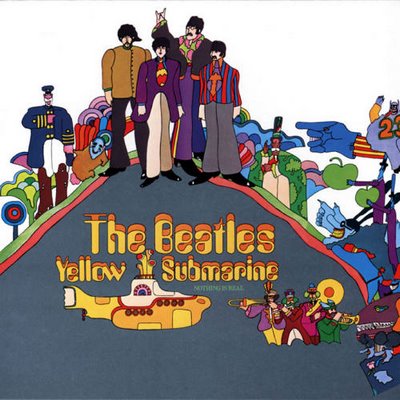 Heinz Edelmann" width="400" height="400" />
Heinz Edelmann" width="400" height="400" />Heinz Edelmann
All the literary prophets and godfathers of this “Brave New World” such as Huxley,Arnold Toynbee and Orwell were deeply implicated in British intelligence: “Aldous Huxley, along with his brother Julian, was tutored at Oxford by H. G. Wells, the head of British foreign intelligence during World War I. Wells’s writings (Time Machine, etc.), along with those of his protégés Aldous Huxley (Brave New World) and George Orwell (1984, Animal Farm), were written as “mass appeal” organizing documents on behalf of Britain’s “en-lightened” world order. Only in the United States are these “science fiction classics” taught in grade school as attacks against fascism. (A contemporary British intelligence operative turned-author, Anthony Burgess, wrote Clockwork Orange in the Wells-Orwell-Huxley tradition as a pornographic celebration of the drug-rock counterculture.)” With regard to the comment on George Orwell (italics above) there is a book available on George Orwell, George Orwell and the Betrayal of Dissent. This book makes the case that Orwell was not a contrarian to state power, he was in fact a solid supporter of state power.
Dada was a movement of a narrow European elite. The Futurists and the Dadaistswere mere lone visionaries of destruction, though more than a few of these men went on to play the role of intellectual apologists for fascism and Stalininsm before these shows went on a world tour. The movements in America were a predictably democratized social fact in themselves that did not merely herald the breakdown of inherited morality, but also advanced the cause as a mass movement.
Futurism condemned the sterility and sham of a Europe on the eve of cataclysm and Dada was a reaction to the ensuing carnage. Surrealism followed as a movement of the post-war wasteland. But these movements, though credited with clearing away some lies and exposing bourgeois hypocrisy and corruption, also by attacking official values, they helped break down the few remaining conventions of restraint and decency left standing after the war.
The story of anti-rationalism did not end with anti-art, and the mood conveyed by Dadaism was not confined to a small intellectual elite. the power and pride of futurism was appropriated as Mussolini’s brand of fascism and as the Berlin Dada was anti-art, so National Socialism became anti-politics. Nazism was a politics of unreason and rejection as well. The paradox and irony of these social and artistic movements was that its influential movers , it appears, often understood its true meaning, implications and ultimate consequences the least.
Stalinism was the aftermath of utopian revolution. Nazism with its industrial murders and its cool abstracted and impersonal technique of mass death justified in the name of a millenarian hope, was no reversion to medieval barbarism. It was a truly modern, post-industrial movement that was passionate and active in personal style while masking a gaping personal emptiness; alienated men driven to ultimate excesses by a frantic longing for sensation.
The real trouble with the romantic anti-rationalist movement of the sixties is that at bottom they are nearly always sentimental in their view of humankind: ” Modern anti-rationalism has a long lineage, and in that lineage it is hard to find more than a few really evil men: ling before futurism and Dada, we had Rousseau, Coleridge, and Byron, as well as Nietzsche and Baudelaire, all men who exalted feeling over thinking, action over reflection. The notion is always to get rid of distortions, to let free what lies in man, to replace fiction with truth, to give love. But what is it that lies in man? Love surely, but rage and hate too. And in modern man a desire to strike out, in despair…at what?” ( Stillman, )
If the sixties movements are ultimately prophetic, our present day cataclysms may in part be derived from it. The wave of the near future appears destined not for rationalism and order, but the reverse. With the ecological movement and what Sam Huntington termed the ”Clash of Civiizations” we see the apolitical and neutral accelerate into an engagement both political and military that shows little sign of abating and fragmenting. The trouble is that eco-green movements for example are far from intrinsically bad. Its the non-rational, anti-rational, magical even, in their professed sober hopes to build a new millenium and society that is most disconcerting. At root is a wild, visionary, transmundane hope that perfect order, perfect justice and perfect harmony can come to prevail when even elementary reason says it cannot be. The result is this great drama of the twenty-first century , enlisting even greater passions that crystalize into predictable reactionary responses.
Bertolt Brecht caught the mood of the interwar despair when he wrote: What kind of medicine tastes bad to the dying?/ What kind of depravity would you not bring about/In order to root about depravity forever?/Yes, submerge us in filth,/But transform the world! Brecht worked hard at pretending to be a good utopian rationalist. Which is fortunate since he appeared to suffer from the same character profile as an upstanding Nazi.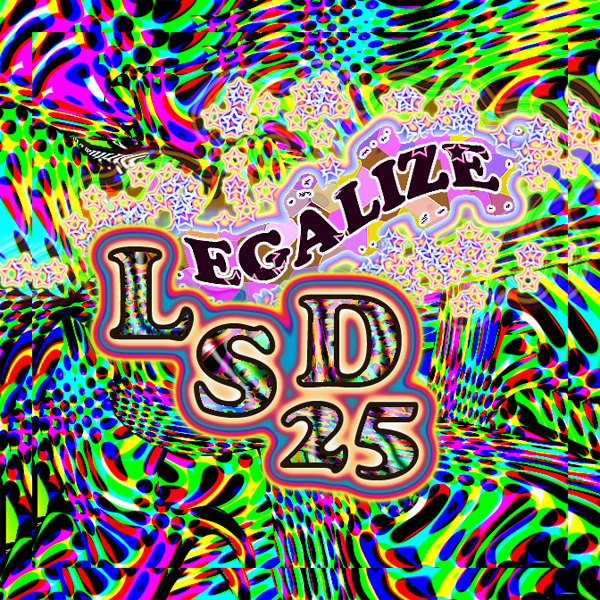
Aldous Huxley on drugs and creativity:
Interviewers: Here this afternoon, as in your book, The Doors of Perception, you’ve been talking chiefly about the visual experience under the drug, and about painting. Is there any similar gain in psychological insight? Huxley: Yes, I think there is. While one is under the drug one has penetrating insights into the people around one, and also into one’s own life. Many people get tremendous recalls of buried material. A process which may take six years of psychoanalysis happens in an hour — and considerably cheaper! And the experience can be very liberating and widening in other ways. It shows that the world one habitually lives in is merely a creation of this conventional, closely conditioned being which one is, and that there are quite other kinds of worlds outside. It’s a very salutary thing to realize that the rather dull universe in which most of us spend most of our time is not the only universe there is. I think it’s healthy that people should have this experience. ( Paris Review, 1960 )



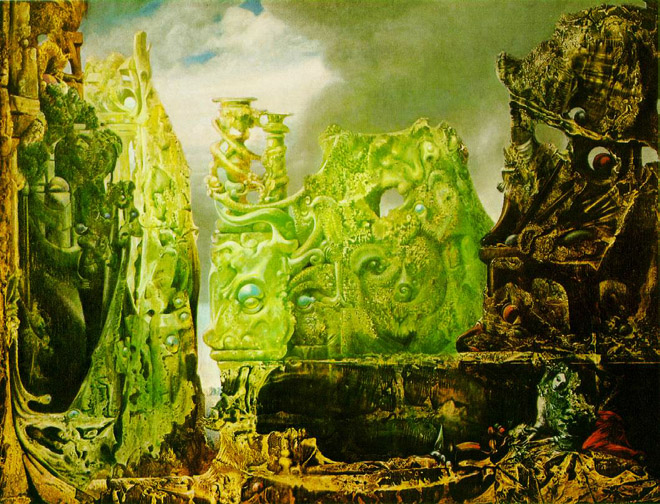
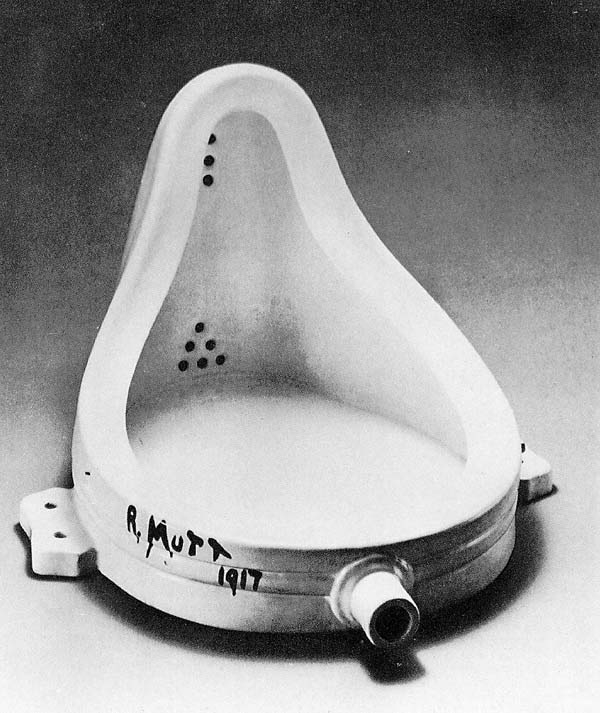
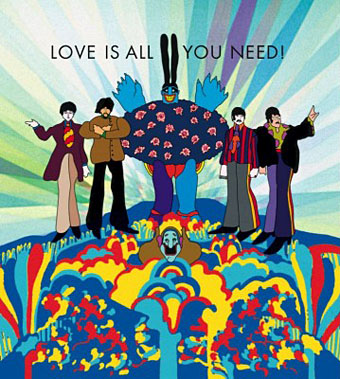
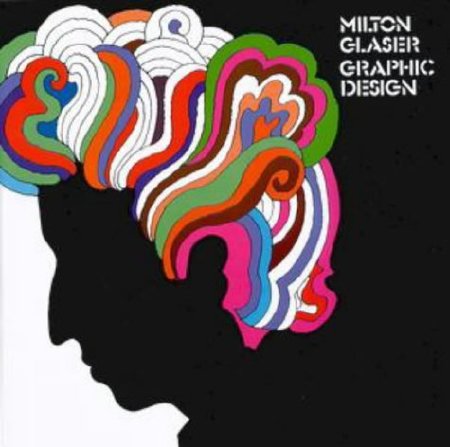

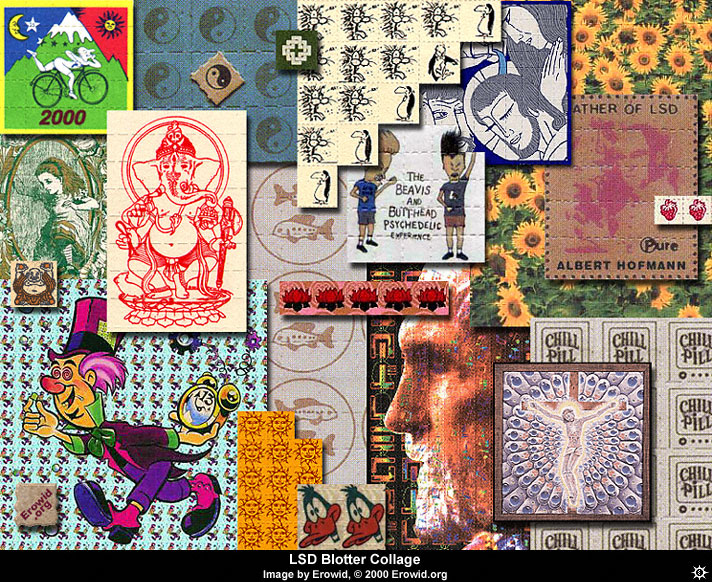



 COMMENTS
COMMENTS
It is fine article. I read it some times. Thanks, Dave.
Nice pictures Dave, but I’m afraid, to me, your pronouncements on Art and Culture seem skewed and out of step. Hurray for the optimists. Boo’ for those who have bad chemical neurolinguistic dogma.
Its possible. If you send me the link for some better pronouncements, I’ll take a look and get back to you. Thanks for taking the time to read anyway.
Best,
Dave
it was a reproduction made on an blotter that hippies were using to take acid.